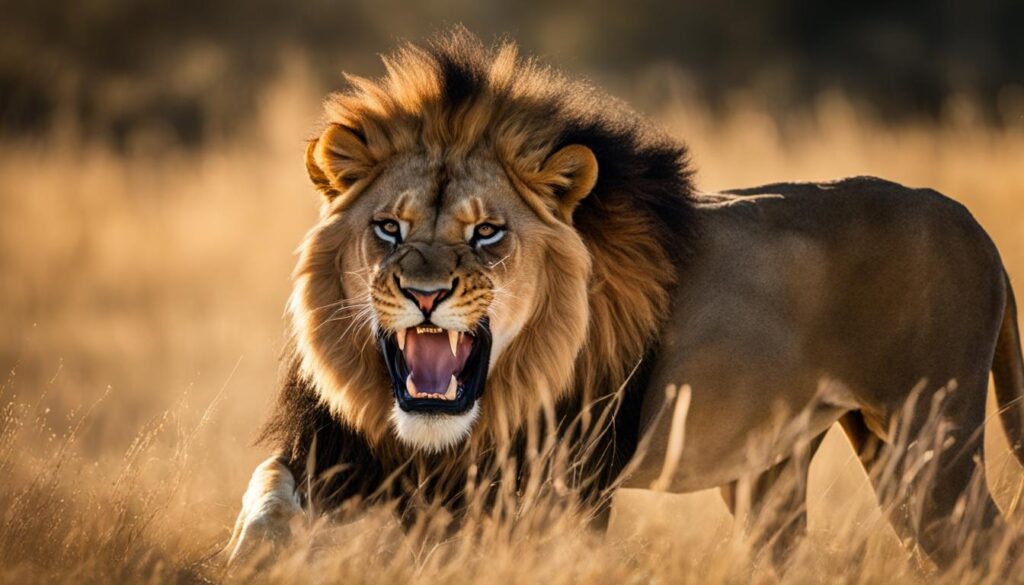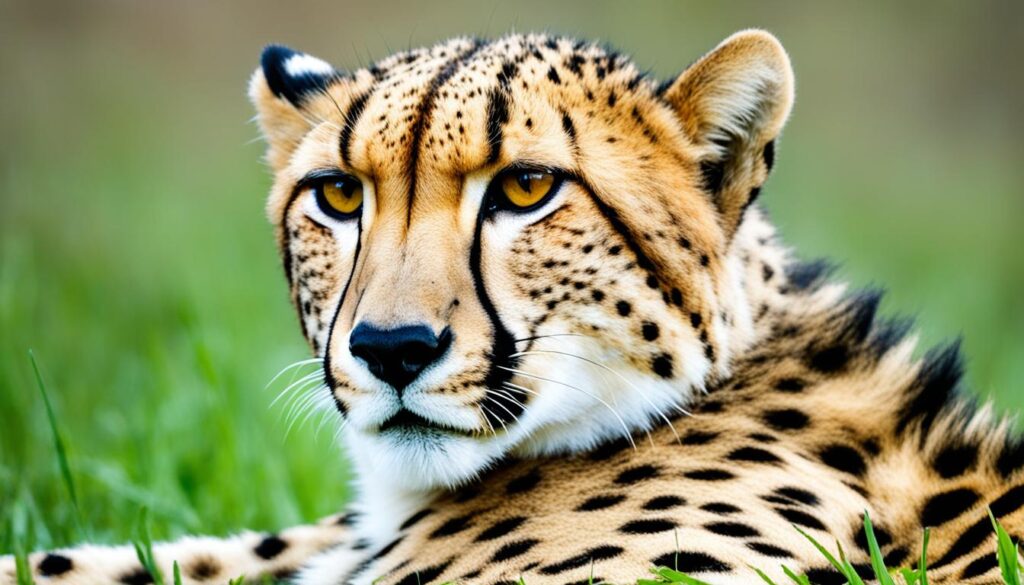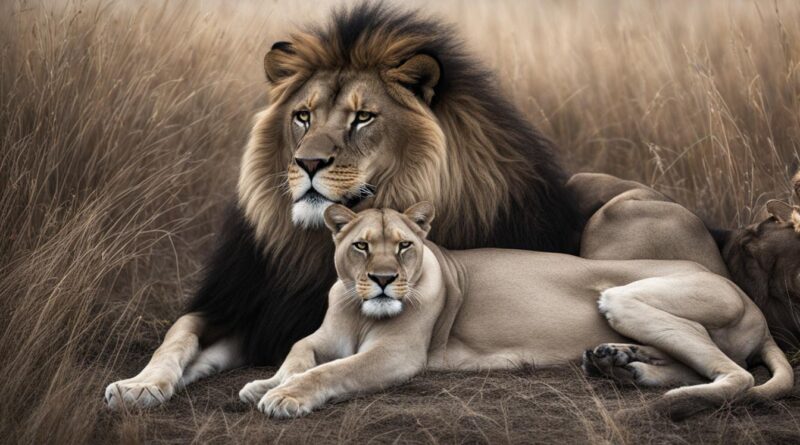Can Big Cats Purr? Exploring Feline Mysteries
When we think of cats, we often imagine them purring contentedly as they curl up in our laps. But what about their larger cousins, the big cats? Can lions, tigers, and other majestic felines produce those soothing purring sounds? Let’s dive into this fascinating topic and uncover the truth behind big cats and their purring abilities.
Key Takeaways:
- Big cats, such as lions, tigers, leopards, snow leopards, and jaguars, cannot purr. Purring is a behavior exhibited by smaller cats like domestic cats and some wild felids like cheetahs.
- The inability of big cats to purr is due to the specialized structure of their voice box, which enables them to roar but prevents them from purring.
- The capacity to purr is determined by the design of the larynx and specific adaptations in the vocal cords, which are absent in big cats.
- Lions, known for their magnificent roars, use this vocalization to communicate with their pride members, mark territory, and assert dominance.
- Cheetahs, although classified as big cats, are an exception and can purr. Their unique larynx anatomy allows them to produce purring sounds as well as high-pitched chirping sounds.
Lions and their Vocalizations
When it comes to vocalizations, lions have a reputation for their powerful and majestic roars. In fact, their roar is considered one of the loudest sounds in the animal kingdom. However, despite their impressive ability to roar, lions are unable to purr.
Unlike smaller cats such as domestic cats and cheetahs, lions do not possess the anatomical structures required for purring. The ability to purr is determined by specific adaptations in the larynx and vocal cords, which are absent in lions and other big cats.
The Roaring of Lions
“The roar of a lion can be heard from several miles away, serving as a powerful auditory signal. Lions use their roar to communicate with other members of their pride, establish their territorial boundaries, and display dominance.”
The distinctive roar of the Barbary lion, a subspecies of African lion known for its dark mane, has made it a legendary figure. Although the Barbary lion is believed to be extinct, there have been occasional reports of possible surviving individuals. However, further research is necessary to confirm their existence.

Lions, Purring, and Barbary Lions
While lions may not purr like their smaller feline counterparts, their vocalizations, especially the iconic roar, play a crucial role in their communication and social interactions. The distinctiveness of the Barbary lion’s roar further emphasizes the diversity within the lion species.
Tigers and Their Vocalizations
Tigers, like lions, cannot purr. They are part of the Panthera genus, which includes other big cats that are also incapable of purring. The largest of the big cat species, the Bengal tiger, is known for its majestic appearance and powerful roar.
Interestingly, there have been reports of mystery big cats resembling tigers in different parts of the world. In Romania, a creature known as the beast of Neamt was later determined to be a wounded Siberian tiger, although there are no known wild Siberian tigers in the region. In Chad, reports of a mountain tiger with reddish fur and white stripes have sparked interest, potentially indicating an undiscovered species or a misidentified animal.
Purring in Feline Species
While big cats cannot purr, cheetahs, despite being classified as big cats, are an exception to this rule. Cheetahs have a unique anatomy in their larynx that allows them to produce a purring sound. Unlike other big cats, cheetahs have a more flexible larynx that enables them to purr.
Purring in cheetahs is associated with contentment, relaxation, and communication with other cheetahs. It is a soothing and gentle sound, suggesting a state of calmness and well-being. The purring vibrations also provide a comforting sensation to cheetahs, helping them to relax and unwind.
Additionally, cheetahs make high-pitched chirping sounds, which are distinct from purring. These chirps serve as a form of communication between cheetahs, especially during social interactions or when they are trying to locate one another in tall grass or dense vegetation.
“Cheetahs are unique among big cats as they possess the ability to purr. This behavioral trait is both fascinating and endearing, contributing to the charm and mystique of these incredible feline species.” – Dr. Sarah Richards, Feline Researcher
Cheetah Purring Sounds Table
| Purring Sounds | Meaning |
|---|---|
| Low, rumbling purr | Contentment and relaxation |
| Gentle, continuous purr | Communication with other cheetahs |
| High-pitched chirping sounds | Locating other cheetahs |

The purring sounds of cheetahs not only provide insight into their emotional states but also play a vital role in their social dynamics. It allows cheetahs to establish and maintain harmonious relationships within their groups, aiding in their overall survival and well-being.
Conclusion
The scientific explanation behind why big cats cannot purr lies in the structure and adaptations of their voice boxes. These adaptations enable them to produce powerful roars, which are unique vocalizations among felids. While lions and tigers are known for their impressive vocalizations, their inability to purr is a direct result of the specialized adaptations required for roaring.
Purring is primarily exhibited by smaller cats, such as domestic cats and cheetahs. The absence of purring in big cats highlights the distinction between these two vocalizations and provides valuable insights into the evolution and vocal capabilities of feline species. It is fascinating to observe how different anatomical features and adaptations have shaped the communication methods of these remarkable animals.
Understanding why big cats cannot purr adds to our appreciation of their individual characteristics and behaviors. While they may not possess the ability to produce the soothing purring sounds that we associate with smaller felines, the mighty roars of lions and tigers evoke a sense of awe and power, showcasing their unique adaptations and survival strategies in the wild.
FAQ
Can big cats purr?
No, big cats such as lions, tigers, leopards, snow leopards, and jaguars cannot purr. Purring is a behavior exhibited by smaller cats like domestic cats and some wild felids like cheetahs.
Why can’t big cats purr?
Big cats have a specialized structure in their voice box that allows them to roar but prevents them from purring. The ability to purr is determined by the design of the larynx and the presence of certain adaptations in the vocal cords, which are absent in big cats.
Do lions purr?
No, lions cannot purr. Lions are known for their majestic roar, which is one of the loudest sounds in the animal kingdom.
Do tigers purr?
No, tigers cannot purr. Tigers, like lions, are part of the Panthera genus, which includes other big cats that are also incapable of purring.
Can cheetahs purr?
Yes, cheetahs can purr. Unlike other big cats, cheetahs have a more flexible larynx that enables them to produce a purring sound.
Why do cheetahs purr?
Purring in cheetahs is associated with contentment, relaxation, and communication with other cheetahs.
What is the scientific explanation for big cats not purring?
The inability of big cats to purr is due to the structure and adaptations of their voice boxes, which allow them to roar. The distinction between purring and roaring in big cats provides insight into the evolution and vocalizations of feline species.


